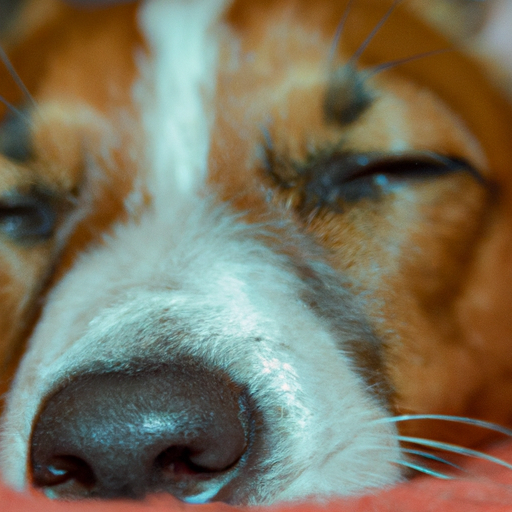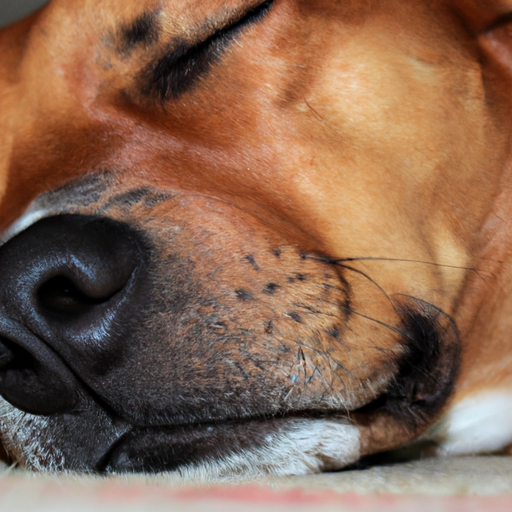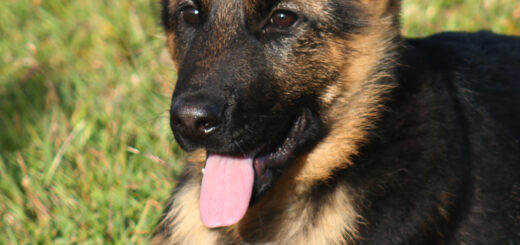Decoding Dog Dreams: What Science Says About Canine Sleep Patterns
Have you ever wondered what dogs dream about when they’re sleeping? Well, science has some fascinating insights! Researchers have discovered that dogs actually do dream, just like us humans. When dogs sleep, they enter into a deep sleep called REM sleep, which stands for Rapid Eye Movement. During this stage, their brains become very active, and they start to dream. But what are they dreaming about? Scientists believe that dogs dream about familiar things, like chasing a ball or playing with their favorite toy. Isn’t that amazing? Keep reading to find out more about the fascinating world of canine sleep patterns!

This image is property of images.unsplash.com.
REM Sleep in Dogs
Definition of REM sleep
REM sleep, which stands for Rapid Eye Movement sleep, is a stage of sleep characterized by rapid eye movements, increased brain activity, and vivid dreams. During this stage, your dog’s body is in a state of paralysis, effectively immobilizing them temporarily. It is called REM sleep because their eyes move rapidly back and forth behind their closed eyelids.
Similarities between human and canine REM sleep
Just like humans, dogs experience REM sleep as part of their sleep cycle. During REM sleep, both humans and dogs have an increased heart rate and irregular breathing patterns. Additionally, brain activity during REM sleep in dogs is similar to that of humans, as both species show heightened brain activity and vivid dreaming during this stage.
Duration and frequency of REM sleep in dogs
The duration and frequency of REM sleep in dogs can vary depending on their age and individual differences. Generally, adult dogs spend about 10-12% of their total sleep time in REM sleep, while puppies and older dogs may spend more time in this stage. It is estimated that dogs have shorter REM sleep periods compared to humans, with each episode lasting approximately 2-5 minutes.
The purpose of REM sleep in dogs
While the exact purpose of REM sleep in dogs is not yet fully understood, it is believed to play a crucial role in the consolidation of memory and learning. During this stage, the brain processes and stores information gathered throughout the day. It also helps dogs regulate their emotions and ensure overall brain health.
Non-REM Sleep in Dogs
Definition of non-REM sleep
Non-REM sleep, also known as NREM sleep or deep sleep, is a stage of sleep characterized by slow brain waves, reduced muscle activity, and a restorative effect on the body. Unlike REM sleep, dogs do not exhibit rapid eye movements or vivid dreaming during non-REM sleep.
Different stages of non-REM sleep in dogs
Non-REM sleep in dogs can be divided into two stages: NREM stage 1 and NREM stage 2. NREM stage 1 is a light sleep stage where dogs easily wake up. NREM stage 2 is a deeper sleep stage where dogs experience slower brain waves and reduced muscle activity. These stages are essential for physical growth, repairing tissues, and replenishing energy levels.
Brain activity during non-REM sleep
During non-REM sleep, brain activity in dogs slows down, and their body temperature drops slightly. This stage allows for rest and recovery, contributing to their overall well-being. Dogs experience moments of relaxation, reduced sensitivity to external stimuli, and a state of calmness during non-REM sleep.
Role of non-REM sleep in memory consolidation
Non-REM sleep plays a crucial role in memory consolidation and mental development in dogs. It helps dogs process and retain information learned during wakefulness, allowing them to better remember and understand new commands, routines, and experiences. Non-REM sleep is particularly important for puppies, as it supports their rapid growth and cognitive development.

This image is property of images.unsplash.com.
Dreaming in Dogs
Evidence of dogs dreaming
There is evidence to suggest that dogs do indeed dream. Research has shown that dogs exhibit similar brain wave patterns during REM sleep as humans do, indicating that they are likely experiencing dreams. Additionally, observations of dogs during sleep have revealed behaviors that resemble actions performed while awake, further supporting the concept of dogs dreaming.
Common behaviors and movements during dog dreams
During REM sleep, dogs may exhibit various behaviors and movements that suggest they are engaged in dream-like activity. You may notice your dog twitching, kicking their legs, wagging their tail, or even barking or whimpering. These actions are believed to be a result of their brain activity during dreaming, as their body temporarily relays signals associated with the dream content.
Similarities between human and canine dreams
Just like humans, dogs experience dreams that can be influenced by their daily experiences, emotions, and memories. Both humans and dogs have complex dream states that often involve reliving past events, interacting with familiar individuals or objects, or exploring imaginary scenarios. It is a fascinating parallel between our two species’ ability to create and experience vivid dream worlds.
The function of dreaming in dogs
The exact function of dreaming in dogs is still not fully understood, but it is believed to have a similar purpose as it does in humans. Dreaming in dogs may help with memory consolidation, emotional processing, and problem-solving. It is thought to be an essential aspect of their cognitive and psychological well-being and contributes to their overall mental health.
Factors Affecting Canine Sleep Patterns
Age and sleep requirements
Just like humans, dogs’ sleep patterns change as they age. Puppies require more sleep than adult dogs, as they are in a phase of rapid growth and development. On the other hand, senior dogs may experience changes in their sleep patterns due to age-related factors such as decreased mobility or health issues. It is important to adjust their sleep routine accordingly to ensure they receive adequate rest.
Dog breed and sleep variations
Different dog breeds have varying sleep needs and patterns. Some breeds, like Greyhounds, may have a greater need for sleep, while others, like Border Collies, have higher levels of energy and may require less sleep. Furthermore, certain breeds may be more prone to sleep disorders or breathing difficulties during sleep, which can affect the quality and duration of their rest.
Environmental factors
The sleep environment plays a crucial role in your dog’s sleep quality. Provide a comfortable and quiet sleeping area for your dog, away from excessive noise, bright lights, or extreme temperatures. Ensure that the bedding is suitable for their needs and provides adequate support and insulation.
Health conditions and medication effects
Certain health conditions, such as pain, allergies, or respiratory problems, can disrupt your dog’s sleep. In some cases, medications used to manage these conditions may also affect their sleep patterns. If you notice changes in your dog’s sleep behavior or suspect an underlying health issue, it is important to consult with your veterinarian for proper diagnosis and treatment.
Routine and sleep quality
Establishing a consistent sleep routine for your dog can help regulate their sleep patterns and improve the quality of their rest. Try to maintain regular mealtimes, exercise schedules, and bedtimes. Consistency and predictability create a sense of security and encourage healthy sleep habits in dogs of all ages.

This image is property of images.unsplash.com.
Sleep Disorders in Dogs
Insomnia in dogs
Insomnia refers to the difficulty falling asleep or staying asleep. Dogs experiencing insomnia may be restless, have trouble settling down, or wake up frequently during the night. Insomnia can be caused by various factors, such as anxiety, discomfort, pain, or an underlying health condition. Identifying the root cause and seeking veterinary assistance is essential for managing insomnia in dogs.
Sleep apnea in dogs
Sleep apnea is a sleep disorder characterized by pauses in breathing during sleep. It can lead to fragmented sleep, snoring, gasping, or choking sounds. Certain dog breeds, such as Bulldogs or Pugs, may be more susceptible to developing sleep apnea due to their short snouts. Your veterinarian can provide a proper diagnosis and recommend appropriate treatment options for sleep apnea.
Restless leg syndrome in dogs
Restless leg syndrome, also known as periodic limb movement disorder, is characterized by involuntary movements or jerking of the limbs during sleep. While more commonly observed in humans, dogs can also experience this sleep disorder. The cause of restless leg syndrome in dogs is not fully understood, but it can be managed with the guidance of a veterinarian.
Narcolepsy in dogs
Narcolepsy is a neurological disorder that causes excessive daytime sleepiness and sudden episodes of uncontrollable sleep, sometimes triggered by strong emotions or excitement. Dogs with narcolepsy may suddenly collapse and fall asleep, even during play or exercise. If you suspect your dog may have narcolepsy, consult with your veterinarian for proper diagnosis and management options.
Tips for identifying and managing sleep disorders in dogs
If you suspect your dog has a sleep disorder, it is important to observe their sleep behavior and consult with your veterinarian. Keep a sleep journal to document any unusual patterns or behaviors. Your veterinarian will be able to conduct a thorough examination, recommend necessary tests, and develop a management plan tailored to your dog’s specific needs.
How to Ensure Quality Sleep for Your Dog
Providing a comfortable sleeping environment
Creating a comfortable and inviting sleeping space for your dog is essential for quality sleep. Choose a clean and well-padded bed that provides proper support and insulation. Consider your dog’s size, breed, and preferences when selecting a bed. Additionally, make sure the sleeping area is located in a quiet and safe part of your home.
Establishing a regular sleep schedule
Dogs thrive on routine, and establishing a regular sleep schedule can help regulate their internal clock and promote better sleep quality. Try to maintain consistent bedtimes and wake-up times for your dog. Remember to consider their specific sleep needs based on age and breed.
Engaging in physical and mental exercise
Regular exercise is not only important for your dog’s physical health but also contributes to their sleep quality. Engaging in physical activities, such as walks or playtime, helps expend excess energy and promotes relaxation. Mental stimulation, such as puzzle toys or training sessions, can also tire your dog’s mind and contribute to a more restful sleep.
Balancing noise levels and light exposure
Excessive noise and bright lights can disrupt your dog’s sleep. Create a peaceful and quiet sleep environment by minimizing noise levels and using curtains or blinds to block out excessive light. Consider using white noise machines or calming music specifically designed for dogs to promote a serene sleeping environment.
Avoiding excessive food or water intake before bedtime
To ensure a restful sleep, avoid feeding your dog a large meal or providing excessive amounts of water close to bedtime. This can help prevent digestive discomfort or the need for nighttime bathroom breaks. Instead, offer smaller meals earlier in the evening and limit water intake within a couple of hours of bedtime.

Sleeping Habits of Puppies
Puppy sleep patterns and developmental stages
Puppies need more sleep than adult dogs due to their rapid growth and development. They often sleep for about 15-20 hours a day, with shorter periods of wakefulness for meals, playtime, and elimination. As they grow older, their sleep patterns will gradually adjust to resemble those of adult dogs.
Creating a safe and quiet sleeping space for puppies
Providing a designated sleeping area for your puppy is important for their safety and comfort. Ensure the sleeping space is free from potential hazards, such as electrical cords or small objects they could swallow. Offer a cozy bed or crate with soft bedding to create a secure and inviting environment.
Supervising and assisting puppies during nighttime
Puppies may require extra assistance during nighttime, especially during the early stages when they are still adjusting to their new surroundings. Take your puppy outside for potty breaks just before bedtime and, if necessary, set an alarm to wake up and take them out during the night. This helps prevent accidents and reinforces good potty training habits.
The importance of crate training for puppies
Crate training can be a valuable tool when establishing healthy sleep habits for your puppy. Dogs are den animals by nature, and a crate provides a safe and secure space for them to rest. It also helps with potty training by teaching them to hold their bladder throughout the night. Remember to introduce the crate gradually and make it comfortable and inviting for your puppy.
Sleeping Habits of Senior Dogs
Changes in sleep patterns as dogs age
As dogs enter their senior years, their sleep patterns may undergo changes. Older dogs often experience more fragmented sleep, meaning they may sleep for shorter periods and wake up more frequently during the night. Additionally, they may spend more time napping during the day to compensate for reduced energy levels.
Health considerations for senior dog sleep
Senior dogs may have underlying health conditions, such as arthritis or cognitive decline, that can impact their sleep. Ensure your dog receives regular veterinary check-ups to monitor their overall health and address any issues that may affect their sleep. Specialized orthopedic beds or supplements may also help alleviate discomfort and promote better sleep quality.
Comfort measures for aging dogs
Providing comfort measures for senior dogs can significantly improve their sleep. Offer a soft, supportive bed that accommodates their changing needs, such as orthopedic memory foam beds. Ensure their sleeping area is warm and draft-free, and consider using blankets or heated pads for added comfort during colder months.
Monitoring and adjusting sleep routines for senior dogs
Keep an eye on your senior dog’s sleep patterns and make necessary adjustments to their routine as needed. If you notice changes in their sleep behavior, consult with your veterinarian for guidance. Modifying their exercise routine and providing mental stimulation can help keep their minds active and promote restful sleep.

Sleep Studies on Dogs
Researchers studying canine sleep patterns
Numerous researchers have been conducting studies to better understand canine sleep patterns. These studies involve monitoring brain activity, collecting behavioral data, and using advanced imaging techniques to investigate the different stages of sleep in dogs. The findings contribute to our knowledge of canine sleep and have implications for veterinary medicine.
Neurological studies on dreaming in dogs
Neurological studies have focused on understanding the intricate workings of the canine brain during sleep, particularly during REM sleep when dreaming occurs. These studies involve observing brain activity and mapping neural pathways to shed light on the similarities and differences in dream patterns between humans and dogs.
Importance of sleep research for veterinary medicine
Sleep research in dogs is vital for enhancing our understanding of various sleep disorders and their impact on overall health and well-being. The insights gained from these studies can help veterinarians diagnose and treat sleep-related issues in dogs more effectively, leading to improved quality of life for our furry companions.
Understanding Your Dog’s Sleep Patterns
Observing and documenting sleep behaviors
By actively observing your dog’s sleep behaviors, you can gain valuable insights into their sleep patterns. Take note of their bedtime routine, duration and quality of sleep, and any noticeable changes in behavior or movement during sleep. Keeping a sleep journal can help you identify any abnormal sleep patterns or potential sleep disorders.
Seeking professional advice for sleep concerns
If you have concerns about your dog’s sleep behavior or suspect a sleep disorder, it is essential to seek professional advice from a veterinarian. They can perform a thorough examination, conduct necessary tests, and provide appropriate guidance and treatment options based on your dog’s specific needs.
Recognizing normal vs. abnormal sleep patterns
Understanding what is considered normal for your dog’s sleep patterns is crucial for detecting any abnormalities. Changes in sleep duration, frequency, or quality, as well as excessive daytime sleepiness or behavioral changes, may indicate underlying medical conditions or sleep disorders. Regular observation and awareness of your dog’s sleep behavior can help you recognize these changes and seek appropriate veterinary care.
Building a stronger bond through comprehension of dog sleep
By developing a better understanding of your dog’s sleep patterns, you can strengthen your bond with them. Recognizing their specific sleep needs, ensuring a comfortable sleep environment, and providing appropriate care can contribute to their overall health and well-being. Additionally, being mindful of their sleep behavior fosters a deeper connection and allows for early intervention in case of any sleep-related issues.









